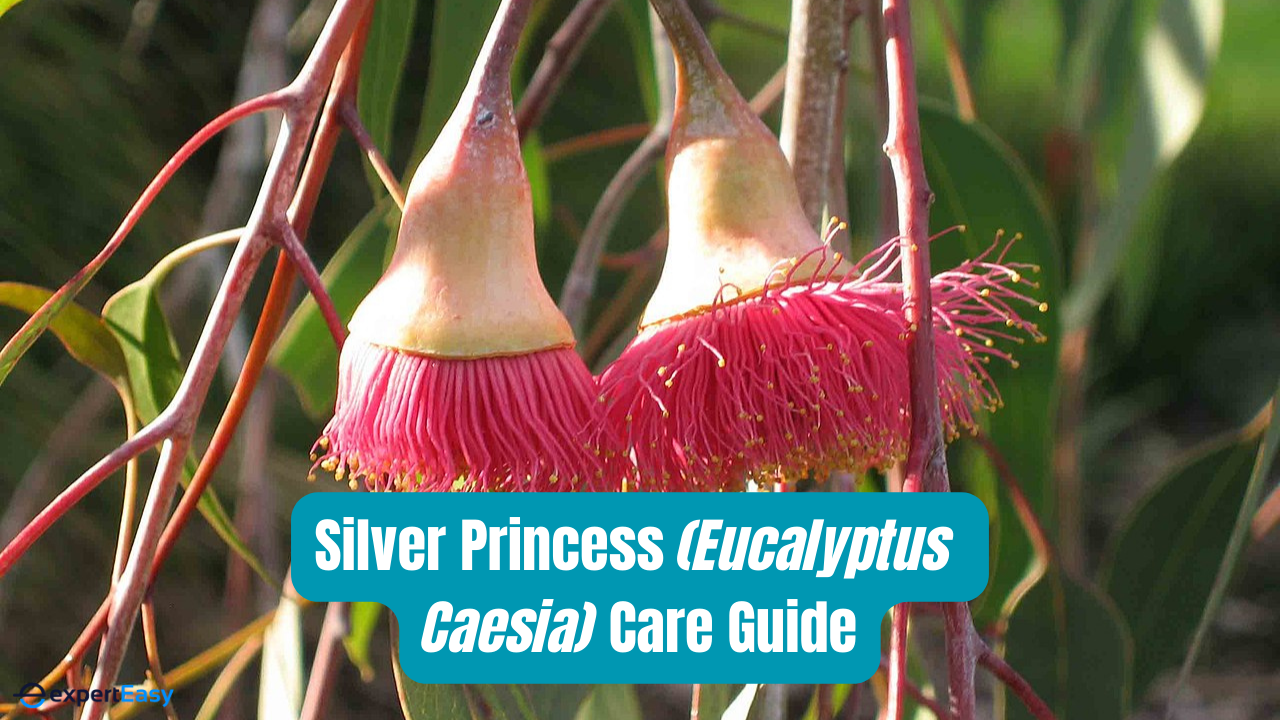Eucalyptus caesia, commonly known as the Silver Princess or Gum tree, is an Australian native tree with captivating silver foliage and a weeping habit. Whether you're hoping to offer a home to your local wildlife, provide some shade, or simply enhance the aesthetic appeal of your outdoor space, this tree can help.
To ensure the successful growth and health of your Silver Princess, however, it is essential to understand its specific care requirements. Thus, in this care guide, we'll explore all you need to know to plant, water, prune, and maintain Eucalyptus caesia in your garden.
About the Silver Princess

Eucalyptus caesia (gum tree or silver princess) is a tall to medium-sized tree, usually reaching a height of 6 to 9 metres when cultivated outside its natural habitat. It features eye-catching pendulous branches, elongated silvery green leaves, and clusters of vibrant pink to red flowers with yellow stamens that blossom from late winter to spring.
The plant is highly valued for its ornamental appeal and ability to tolerate semi-arid conditions. The name “silver princess” comes from the powdery silvery-white hue of the leaves and stems. Its silvery-green leaves not only gleam in the sunlight but transform from a youthful red to a mature deep green with that signature silvery tint.
Growing Eucalyptus Caesia
Setting down roots with the Silver Princess? Here's a step-wise roadmap to ensure it reaches its majestic potential.
Selecting the Ideal Planting Location
Choosing the right planting location is crucial for the successful growth of your Silver Princess. It prefers full sun exposure but can tolerate partial shade. Ensure the selected area has well-draining soil to prevent waterlogging, which can be detrimental to the tree's health. The Silver Princess is best suited for ANBG (Australian National Botanic Gardens) hardiness zones 3 to 5.
Soil Preparation
Before planting your Eucalyptus caesia, prepare the soil adequately. The ideal soil for Silver Princess is slightly acidic to neutral (pH 5.5-6.7) and well-draining. If your garden's soil is a bit like beach sand or thick clay, a good dose of compost will do wonders. This will promote healthy root development and moisture retention.
Planting Your Silver Princess

Alright, it's time to get those hands dirty and introduce the Silver Princess to her new home. Here's an in-depth, step-by-step guide to ensure she's planted just right:
1. Preparation
Before you begin, ensure you've got the right tools on hand. You'll need a shovel, some gloves, and your Silver Princess, of course. Start by digging a hole that's about 1.5 to 2 times wider than the tree's root ball. This allows the roots ample space to spread and grow without feeling constricted.
2. Positioning the Tree
Once your hole is prepped, gently remove the Silver Princess from its container. Be careful to support the trunk and roots to avoid unnecessary strain or damage. Place the tree in the middle of the hole. This positioning will ensure it grows straight and true.
3. Backfilling
Begin filling the hole with the soil you removed earlier. As you do so, pat the soil down gently around the tree's roots. This eliminates air pockets and provides solid support. Remember, the tree shouldn't be buried any deeper than it was in its original pot. You should be able to see the point where the roots start branching out from the main trunk, known as the root flare.
4. Watering
Once you've filled the hole and the tree is standing upright, it's time to water. Giving it a deep soak ensures that the roots get the moisture they need to settle into their new environment. This also helps the surrounding soil to settle.
5. Ongoing Care
While not an immediate step in the planting process, remember that the first few weeks are crucial. Keep the soil consistently moist, but not soggy. The Silver Princess, like all trees, doesn't like 'wet feet'.
Caring for Your Silver Princess
Looking after your Silver Princess isn't tricky, but it's crucial. From simple watering steps to getting set for winter, let's explore how to care for the plant in your backyard.
Watering Requirements
Establishing a proper watering routine is crucial during the early stages of your Silver Princess's growth. While this species is known for its drought tolerance, regular watering is necessary until it becomes established. Water deeply but infrequently, allowing the soil to dry out between waterings. During hot and dry periods, provide additional irrigation to prevent stress.
Pruning and Shaping
Pruning plays a vital role in maintaining the health, shape, and overall aesthetics of your Silver Princess. Best times? Late winter or the cusp of spring before she starts shooting out new growth. Remove any dead, damaged, or diseased branches. Additionally, thin out dense growth to improve air circulation and reduce the risk of fungal diseases. But remember to keep the iconic weeping look, so no drastic chops.
Fertiliser Application
Eucalyptus caesia generally does not require heavy fertilisation. However, if the tree shows signs of nutrient deficiency, you can apply a slow-release, balanced fertiliser in early spring. Avoid excessive use of nitrogen-rich fertilisers, which can lead to excessive vegetative growth and compromise the tree's overall health.
Mulching
Applying a layer of organic mulch around the base of the Silver Princess offers several benefits. It helps retain soil moisture, regulates soil temperature, suppresses weed growth, and enhances the visual appeal of the garden. Maintain a mulch layer of about 5 to 10 cm, ensuring it does not touch the tree's trunk.
Winter Care
The Silver Princess usually thrives without any special care in regions with mild winters. However, in colder climates, protect the tree from frost or freezing temperatures by covering it with a frost cloth or using a temporary windbreak.
Dealing With Common Pests and Diseases

The Silver Princess is generally resistant to most pests and diseases. However, it can occasionally be susceptible to infestations by sap-sucking insects like aphids or psyllids. Let's go over them.
Aphids
Aphids have an affinity for a wide array of plant species, which they attack by siphoning fluids, causing stunted growth and misshapen leaves and buds. Their piercing mouthparts can also transmit plant viruses. They tend to appear during environmental shifts, particularly in spring and fall, clustering at branch tips to feast on tender plant tissue.
Preventing and Managing Aphids:
- Maintain minimal weed growth, especially near the Silver Princess.
- Encourage natural predators like ladybugs and lacewings.
- Consider various control products, both organic and inorganic, following professional recommendations and label instructions meticulously.
Powdery Mildew
Powdery mildew afflicts plants lacking adequate air circulation and sunlight, particularly in regions with cool nights and warm, humid days. This eerie white or gray fungus typically appears on leaf surfaces and fruit, causing leaves to yellow, curl, and drop prematurely.
Preventing and Managing Powdery Mildew:
- Ensure proper spacing to allow for ample light and airflow.
- Water plants from below to keep foliage dry.
- Use nitrogen fertiliser sparingly.
- Apply fungicides as a preventive measure following label instructions rigorously.
- Maintain cleanliness by removing fallen leaves, flowers, and debris in the fall.
Pythium and Phytophthora Root Rot
Root rot, caused by Pythium or Phytophthora fungi, occurs in excessively moist soil containing fungal spores. It begins with discolouration and shrinking of stem bases, followed by wilting and death of upper leaves.
Preventing and Managing Root Rot:
- Remove and discard affected plants.
- Avoid excessive fertilisation.
- Practice restrained watering and ensure well-drained soil before planting.
Scale Insects
In their youth, scale insects crawl until they find an ideal feeding spot. Once mature, the females lose their legs and remain encased in a protective hard shell. They appear as bumps, typically on the undersides of the Silver Princess' leaves, equipped with piercing mouthparts to extract plant sap. Scales can weaken plants, leading to yellowing leaves and leaf drops.
Preventing and Managing Scale Insects:
- Isolate infested plants from uninfected ones.
- Seek advice from local garden professionals.
- Foster the presence of natural predators, such as parasitic wasps, in your garden.
Are you planning a garden redesign or in need of some landscaping advice? Our guide on how to find the best landscaper in Australia is a great resource. These professionals provide everything from design inspiration to full-service landscaping, helping you transform your outdoor space into a beautiful garden masterpiece.
🪴Need Assistance With Gardening?
Whether you're a seasoned green thumb or just starting out in gardening, there's always more to learn. Immerse yourself in our guide to finding the perfect gardener in Australia. These top-rated professionals offer a variety of services, from plant selection to garden maintenance, ensuring your garden remains vibrant and healthy.
🌲Seeking Help With Lawn Care?
Maintaining a beautiful lawn can be a significant undertaking. If you're in need of expert assistance, look no further than our carefully curated guide on choosing the right lawn mowing service in Australia. These experts can help keep your outdoor spaces at their greenest and cleanest best with their lawn mowing and care expertise.
Frequently Asked Questions (FAQs)
Here are some frequently asked questions about Eucalyptus caesia.
How tall does a Silver Princess tree grow?
Silver Princess trees can grow up to 30 feet (9 metres) tall, although the height can vary depending on the growing conditions and the specific cultivar. They have a relatively narrow and weeping growth habit, which adds to their aesthetic appeal.
When does Silver Princess bloom?
Silver Princess trees typically bloom in late winter or early spring, usually between June and September in the Southern Hemisphere. During this time, the tree produces beautiful pink or red flowers with prominent stamens. The flowers attract birds and insects, making it a favourite among gardeners.
How do I care for a Silver Princess tree?
Silver Princess trees prefer a sunny location with well-draining soil. They are relatively low-maintenance once established but require regular watering during the establishment phase. Pruning is generally not necessary unless you want to shape the tree or remove any dead or damaged branches. Additionally, it is beneficial to provide some protection from frost when the tree is young.
Can I grow Silver Princess outside of Western Australia?
While Silver Princess is native to Western Australia, it can be grown in other regions with similar climate conditions. It thrives in Mediterranean climates with mild, wet winters and hot, dry summers. However, it may not tolerate extreme cold or frost, so it is best suited for temperate or subtropical regions. If you live in a colder climate, you can try growing it in a large container and bringing it indoors during the winter months.

Wrapping Up
The Silver Princess or Eucalyptus caesia is a remarkable tree that brings beauty, grace, and an Australian touch to any garden. By understanding its specific care requirements, including planting in a suitable location, providing adequate water, occasional pruning, and monitoring for pests and diseases, you can ensure the health and longevity of your Silver Princess.
With proper care, this majestic tree will continue to grace your garden for years to come, captivating both you and your visitors with its silver foliage and stunning weeping habit. If she's sparked an interest, there's a whole range of fast-growing Australian native trees waiting to be explored.








